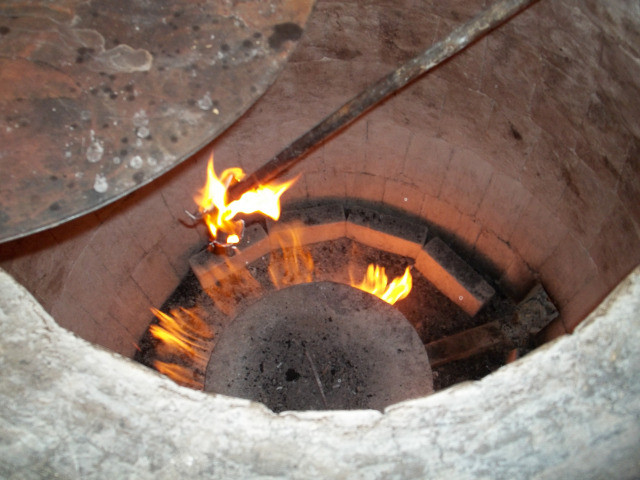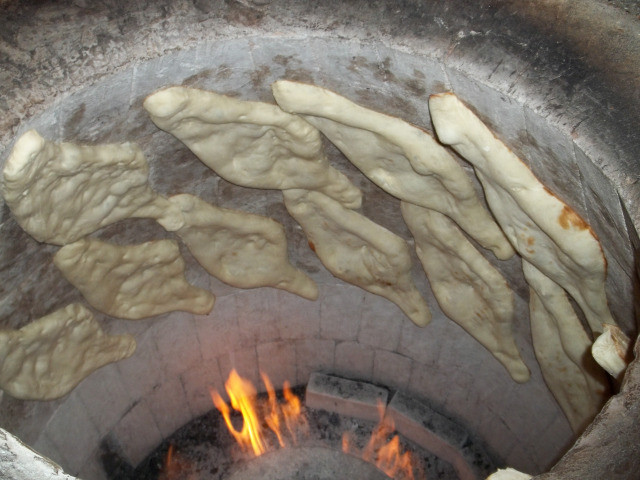How It's Made? Staple Food Of Georgia
Hello friends hope you are all doing well out there. Here I would like to share with you an experience that I was able to gain in a Georgian local bakery. I was able to see how exactly is the Georgian bread is made. It can be said as one of the staple food of the Georgian people having a unique shape. It was really interesting to watch the entire process of bread making. I guess that's enough with the introduction and now let me share my experience with you.
It was quite a sunny day in Tbilisi and I was wandering through the city streets. As I was really hungry I stopped by a small bakery in the corner of a street. I got a lobiani that was really delicious and I was eating it. This is when I met this man named Misha who was a baker. He was very kind in speaking and was just enquiring me about where I was from and what am I doing here so on. The conversation grew up and I asked him why the shape of the Georgian bread is unique. He just told me something which I couldn't really understand after which I asked him If i could see how the bread is made. He had no hesitations in it and took me in to the bakery where I was allowed to see the entire process of bread making. The following process is based on what I saw and what I understood from his explanations.

The baker first dressed himself up with an apron and a cap which appeared to be really hygienic. It prevented his hair strands falling into the dove accidentally and also making a mess on himself during cooking. He said that the oven like that is used to cook should be lighted first. To light it the baker took out a large iron base from the bottom of the oven like thing and used a long rod with fire to light it up.
He then went to prepare the dough that is essentially need to make bread. He put a sack of flour, with salt, yeast and sugar in a big container. The amount of ingredients used were enormous as he was about to make breads to sell in his bakery. He started to mix all the ingredients together with his hand. I was actually shocked first. He was able to mix such a huge mixture with his hand. The mixing process continued for 5 or 10 minutes after which he covered the dough mixture. He covered the mixture with a cloth and a plastic sheet.

He left the dough undisturbed for hours for the yeast to ferment and increase the size of the dough. After 2 hours the dough was two folds its original size and he said that it was ready to make breads. He took small pieces of dough and kept them on a measuring scale. He said that each dough ball should weigh about 600grams for getting a perfect bread. After weighing the dough balls are placed on a surface that is dusted with flour that prevents the dough from sticking to the surface. He made the dough into a mound shaped balls first then he rolled the dough making them spindle shaped. They have a broad center portion with tapering ends. After making this shape he covered the dough again with a cloth and a plastic sheet. This will again help the dough to increase a little in its size. This time the dough is left undisturbed only for a few minutes after which he uncovers the dough.
He took a single piece of the dough and placed it in a wooden pad which he called as "Lapati". He stretched the dough to the corners of Lapati and then he carried the stretched dough towards the hot oven like nothing. There was a hole in Lapati with which the baker was able to hold it. With the help of Lapati he presses the dough against the wall of the oven which is really hot. The dough must be pressed tightly or else the dough will fall of from the wall. The baker repeats the same thing again and again until the oven like thing gets filled.

The dough is placed only at the top because if you place the dough in the bottom layer then the dough will get burnt due to high temperature. It takes about 10 minutes for the bread to get baked. Then now comes another technique that requires some skills. To remove the bread from the walls of the oven he used two instruments. One he said as Kavi and the other was Safkheki. With the help of Kavi the baker was able to pierce the bread and hold it in place and with the help of Safkheki he was able to remove the baked bread from the wall. After removing the baked bread from the walls of the oven like thing they are allowed to cool. The smell was really good and it was really great to see how they make this staple Georgian food. The bread is called as Shoti's Puri in Georgian and when people buy it from the shop the bakers usually wrap it in a piece of paper as it is difficult to accomodate in a plastic cover.
It was a really nice day out as I got to know something new about Georgian cusine. Although its not such a complex dish to make it's a very common food in Georgia and often you can see people in streets carrying a piece of this bread wrapped in papers. The day was good and it was a really interesting process to witness. Hope you liked it too. If you have any suggestions or comments feel free to say them below. Till i write my next article keep smiling and cheers.
Photo gallery
Content available in other languages
Want to have your own Erasmus blog?
If you are experiencing living abroad, you're an avid traveller or want to promote the city where you live... create your own blog and share your adventures!
I want to create my Erasmus blog! →

















Comments (0 comments)